58 search results - page 6 / 12 » Learning to Walk through Imitation |
EMNLP
2011
12 years 9 months ago
2011
We consider the problem of performing learning and inference in a large scale knowledge base containing imperfect knowledge with incomplete coverage. We show that a soft inference...
ICONIP
2009
13 years 7 months ago
2009
Abstract. Wild rodents learn the danger-predicting meaning of predator bird calls through the paring of cues which are an aversive stimulus (immediate danger signal or unconditione...
RA
2003
13 years 11 months ago
2003
Behavioural cloning is a method by which a machine learns control skills through observing what a human controller would do in a certain set of circumstances. More specifically, t...
ICRA
2010
IEEE
13 years 8 months ago
2010
IEEE
— The goal of this research is to enable mobile robots to navigate through crowded environments such as indoor shopping malls, airports, or downtown side walks. The key research ...
JCAL
2011
13 years 4 months ago
2011
: Players of epistemic games--computer games that simulate professional practica— have been shown to develop epistemic frames: a profession’s particular way of seeing and solvi...

